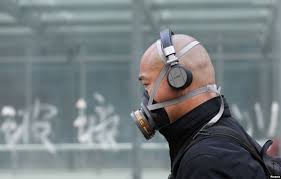A Berkeley Earth study of newly released air quality data from 1,500 sites across East Asia has found that airborne particulate matter contributes to 1.6 million deaths per year in China. That is equivalent to about 4,400 per day, and makes up approximately 17% of all deaths in China. The New York Times’ Dan Levin reports:
According to the data presented in the paper, about three-eighths of the Chinese population breathe air that would be rated “unhealthy” by United States standards. The most dangerous of the pollutants studied were fine airborne particles less than 2.5 microns in diameter, which can find their way deep into human lungs, be absorbed into the bloodstream and cause a host of health problems, including asthma, strokes, lung cancer and heart attacks.
[…The researchers] analyzed four months’ worth of hourly readings taken at 1,500 ground stations in mainland China, Taiwan and other places in the region, including South Korea. The group said it was publishing the raw data so other researchers could use it to perform their own studies.
Berkeley Earth’s analysis is consistent with earlier indications that China has not been able to successfully tackle its air pollution problems.
[…] The Berkeley Earth paper’s findings present data saying that air pollution contributes to 17 percent of all deaths in the nation each year. The group says its mortality estimates are based on a World Health Organization framework for projecting death rates from five diseases known to be associated with exposure to various levels of fine-particulate pollution. The authors calculate that the annual toll is 95 percent likely to fall between 700,000 and 2.2 million deaths, and their estimate of 1.6 million a year is the midpoint of that range.
[…] Much of China’s air pollution comes from the large-scale burning of coal. […] [Source]
The Times’ report continues to note that the primary sources for Beijing’s notoriously smoggy skies lie 200 miles outside of the city, a fact that could complicate Beijing’s promise to clean up the capital’s air for the 2022 Winter Olympics. Beijing has previously demonstrated success in scrubbing the skies when under the international spotlight, for example during the 2008 Summer Olympics, or during last year’s APEC Summit.
The Guardian quotes the study’s lead author Robert Rohde to put China’s air pollution into an American perspective, and notes praise of the new report from the scientific community:
Study lead author Robert Rohde said 38% of the Chinese population lived in an area with a long-term air quality average the US Environmental Protection Agency called “unhealthy.”
“It’s a very big number,” Rohde said. “It’s a little hard to wrap your mind around the numbers. Some of the worst in China is to the south-west of Beijing.”
To put Chinese air pollution in perspective, the most recent American Lung Association data shows that Madera, California, has the highest annual average for small particles in the United States. But 99.9% of the eastern half of China has a higher annual average for small particle haze than Madera, Rohde said.
[…] As China started to clean up its air, limiting coal use, it would also reduce emissions of carbon dioxide, the chief global warming gas, Rohde said. [Source]
Mounting public concern over air quality in recent years has prompted government reaction. In March 2014, Premier Li Keqiang declared “war against pollution” at the opening of the NPC. In November 2014, Xi Jinping singed an informal agreement with Washington pledging to cap emissions by 2030 (which met mixed reactions from the international community), and in June Beijing submitted a formal pledge on carbon reduction to the U.N. The central government has also promised to punish local officials for making decisions that negatively impact the environment.
There has been indication that recent efforts are having some affect: China’s coal production last year fell 2.1%—the first such decline of the century. A recent data analysis from Greenpeace (via CDT) shows that the cut in coal has already lowered carbon emissions. This progress, however, is not being equally enjoyed across China.
Despite the government’s efforts to tackle China’s infamous air quality problem, there has been little official sympathy for environmental activism, and public discussion of the issue remains strictly regulated. In March, former state media anchor Chai Jing’s viral film “Under the Dome” was quickly ordered offline, and online discussion of the documentary forbidden. Also in March, several environmental activists were detained for calling on the government to increase anti-pollution measures.








